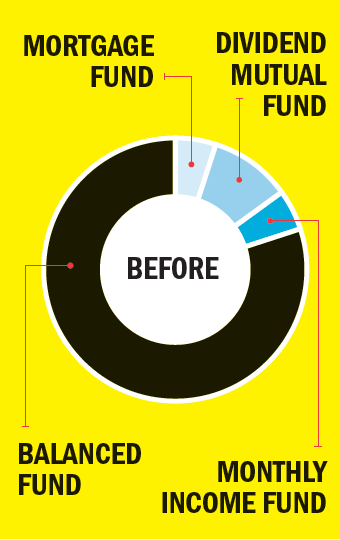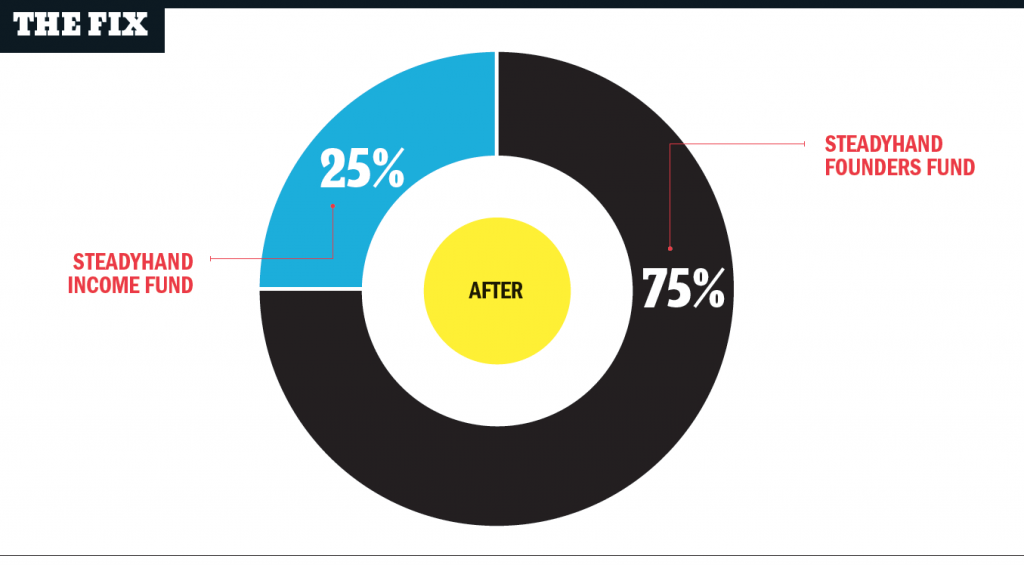Best way to invest a large sum of money
The key is to keep it simple
Advertisement
The key is to keep it simple
 Moyra Thompson, 60, is retired and her $600,000 mortgage-free house is up for sale. “I want to sell before boomers flood the market with homes,” says Moyra, who receives $2,100 a month from two small pensions and will start collecting CPP at age 65. Right now, her $150,000 portfolio is invested in bank mutual funds with an overall management expense ratio (MER) of 1.9%, split evenly between fixed income and equities—but even with an additional $600,000 Moyra is concerned her money won’t last into her 90s. “I’ll need $15,000 net a year from my portfolio. I’m not sure the 50% fixed income and 50% equity split will give me that.”
Certified financial planner Chris Stephenson of Steadyhand Investment Funds in Vancouver says that if Moyra’s goal is to withdraw $15,000 annually from a $750,000 portfolio (an extraction rate of 2%), she’ll have no problems. In fact, this is easily achievable with her current asset mix of 50% stocks and 50% fixed income, and Stephenson sees no reason to change this. “Investors often feel they have to change investment strategy when they get a large sum of money. But if your goals can be met with your present strategy, it makes sense to continue with it.”
Moyra Thompson, 60, is retired and her $600,000 mortgage-free house is up for sale. “I want to sell before boomers flood the market with homes,” says Moyra, who receives $2,100 a month from two small pensions and will start collecting CPP at age 65. Right now, her $150,000 portfolio is invested in bank mutual funds with an overall management expense ratio (MER) of 1.9%, split evenly between fixed income and equities—but even with an additional $600,000 Moyra is concerned her money won’t last into her 90s. “I’ll need $15,000 net a year from my portfolio. I’m not sure the 50% fixed income and 50% equity split will give me that.”
Certified financial planner Chris Stephenson of Steadyhand Investment Funds in Vancouver says that if Moyra’s goal is to withdraw $15,000 annually from a $750,000 portfolio (an extraction rate of 2%), she’ll have no problems. In fact, this is easily achievable with her current asset mix of 50% stocks and 50% fixed income, and Stephenson sees no reason to change this. “Investors often feel they have to change investment strategy when they get a large sum of money. But if your goals can be met with your present strategy, it makes sense to continue with it.”
 Still, there are a few things Moyra can do to hold onto more of her money, Stephenson adds. Investment costs are important, and Moyra could lower her current portfolio’s 1.9% MER by switching over to no-load, low-fee funds. He recommends a portfolio comprised of Steadyhand’s Founders Fund (75% of holdings) and Income Fund (25%)—which would still give Moyra an asset mix of 50% stocks and 50% fixed income. Her all-in costs? “Assuming a portfolio value of $750,000, Moyra would pay roughly a 0.9% MER—a very affordable amount to pay for a diversified portfolio,” says Stephenson.
Moyra should also set aside two years’ worth of living expenses, or about $30,000, in a savings account. “She should replenish this every 18 months by selling some of her investments in the Founders Fund and Income Fund,” says Stephenson. Finally, Moyra should consider meeting with a fee-for-service planner annually to ensure her financial plan stays on track.
Still, there are a few things Moyra can do to hold onto more of her money, Stephenson adds. Investment costs are important, and Moyra could lower her current portfolio’s 1.9% MER by switching over to no-load, low-fee funds. He recommends a portfolio comprised of Steadyhand’s Founders Fund (75% of holdings) and Income Fund (25%)—which would still give Moyra an asset mix of 50% stocks and 50% fixed income. Her all-in costs? “Assuming a portfolio value of $750,000, Moyra would pay roughly a 0.9% MER—a very affordable amount to pay for a diversified portfolio,” says Stephenson.
Moyra should also set aside two years’ worth of living expenses, or about $30,000, in a savings account. “She should replenish this every 18 months by selling some of her investments in the Founders Fund and Income Fund,” says Stephenson. Finally, Moyra should consider meeting with a fee-for-service planner annually to ensure her financial plan stays on track.
Share this article Share on Facebook Share on Twitter Share on Linkedin Share on Reddit Share on Email